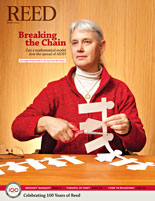
IRIS login | Reed College home Volume 91, No. 1: March 2012
Diversity at Reed
I was appalled, discouraged, and saddened to see no faces of clearly African descent among the 24 new faculty members pictured in the recent Reed magazine. It didn’t encourage me that only one of seven new tenure-track appointees appears to be from a minority community. This pattern leaves me wondering whether the presidential search will be broad, innovative, and bold enough to position Reed College well for the 21st-century diversity of our nation and global interconnectedness.
The college proclaims its emphasis on increasing diversity, but if students do not “see themselves” generously among faculty, the effort cannot be considered a robust one. The effect may be subtle, but it can discourage minority students from applying and from deciding to actually attend if accepted, and can contribute to their dropping out. When I attended Reed in 1960–64, there were few women faculty. So, I know first hand the negative effect this lack can produce. It would have helped me to have the informal mentoring that is part of sharing basic similarities.
Reed has hired in a variety of faculty positions in recent years, but diversity does not appear to be improving. It looks like you are still giving unacknowledged preference to those who are most similar to existing faculty members.
Breaking the mold of hiring those who look and present as you do is difficult. It is harder to predict how one will succeed and how they will fit in. Why invite discomfort? Apparently Reed has not faced this challenge in a proactive, organized way; students and society are negatively impacted as a result.
Had it not been for affirmative action and—dare I say? quotas!—I might have spent my working life in jobs toward which my gender aimed me and from which my aptitudes and interests rebelled. I am grateful for the opportunity.
In the 1960s and ’70s, it was difficult for me to be hired into “men’s jobs” because employers could not predict my performance and I didn’t fit their preconceptions of the occupants of the position. I was a risk. Who wants to hire a risk? Without quotas, I doubt I would have been launched into the variable, challenging, and satisfying succession of positions that made my working life successful.
Perhaps Reed College needs an internal, informal quota system for diversity. Maybe when two candidates are similarly qualified and the one closest to your mold (including alumni) appears slated for selection, that predilection requires serious reconsideration at the highest levels. I am not qualified to propose a solution, but I clearly see a problem and am pointing it out in hope you will take action to solve it.
Editor's Note: (from Crystal Ann Williams, Dean for Institutional Diversity & Associate Professor of Creative Writing, and from Patrick McDougal, Acting Dean of the Faculty & Howard Vollum Professor of Chemistry) Thank you for your thoughtful letter. We are always grateful when presented with the ideas of alumni engaged in imagining how Reed might become a more inclusive, intentional, and culturally and intellectually pluralistic community. While we acknowledge imperfection in this regard, we are in the process of developing means by which to identify, target, and hire more faculty from underrepresented ethnic groups. Most contemporary efforts related to diversifying the faculty are a result of a faculty resolution dated April 5, 2004, which reads in part: “As the faculty ponders ways to improve the college, the faculty resolves that the ethnic diversification of the faculty and student bodies at Reed College should be among the highest priorities during the upcoming [current] capital campaign.” We have certainly not met our aspiration, which is to become a significantly more ethnically diverse institution on all levels—in the student, faculty, and staff bodies—but since 2001 we have added eight tenure track members from underrepresented ethnic groups to our faculty. Your letter sparked the realization that we have not formally engaged alumni in the conversation about diversity and inclusivity. Look for an article in the next issue of Reed about faculty diversity, its relevance to the academic mission of Reed, and how we are positioned in the world of the highly selective liberal arts college.


LATEST COMMENTS
steve-jobs-1976 I knew Steve Jobs when he was on the second floor of Quincy. (Fall...
Utnapishtim - 2 weeks ago
Prof. Mason Drukman [political science 1964–70] This is gold, pure gold. God bless, Prof. Drukman.
puredog - 1 month ago
virginia-davis-1965 Such a good friend & compatriot in the day of Satyricon...
czarchasm - 4 months ago
John Peara Baba 1990 John died of a broken heart from losing his mom and then his...
kodachrome - 7 months ago
Carol Sawyer 1962 Who wrote this obit? I'm writing something about Carol Sawyer...
MsLaurie Pepper - 8 months ago
William W. Wissman MAT 1969 ...and THREE sisters. Sabra, the oldest, Mary, the middle, and...
riclf - 10 months ago